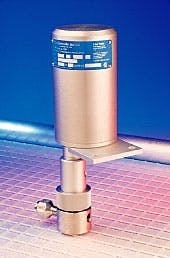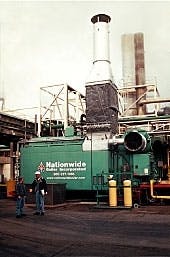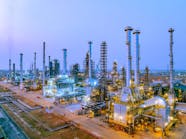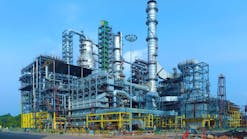Remote site electric to pneumatic converter
The Type 1200 Eltop electric to pneumatic converter is a rugged, low power consumption pressure regulator designed for remote locations.
It uses an electronically operated reversible 24 v dc motor, which accurately positions the stainless steel. diaphragm controlled pressure-regulating valve and converts the dc signal to a variable pneumatic output.
This unit has no power consumption except when the motor is being operated to change the pressure setting. The rest of the time the 1200 simply acts as a spring-operated regulator.
Another feature is fail-safe operation. If there is a power failure at the site, the regulated output pressure and valve position remain the same. The converter comes with limit switches that help prevent motor burnout by automatically stopping the motor when the high or low set point is reached. Another set of switches provides feedback, which informs the operator (remote or on-site) whether the valve being controlled is in an open or closed state.
The explosionproof, NENMA7X enclosure and stainless steel regulator construction allow the unit to not only operate in remote, hazardous area applications but also withstand the forces of hostile environments. The stainless steel construction of the main regulating valve helps prevent corrosion and ensures long, uninterrupted operation. In addition. the stainless in-line filter protects against potential contamination in the supply line.
The converter is available with a 12 v dc or 24 v dc motor and four motor speeds. Supply port connections are 1/4 in. NPT. Its temperature range is -40° to +150° F. Operating pressure range is 0-30 psig. Flow capacity is 5 scfm, and relief capacity is 1.4 scfm.
The unit is suited for valve actuation applications on gas transmission and distribution pipe lines, SCADA operated systems, and DCS operations.
Source: ControlAir Inc., 8 Columbia Drive, Amherst, NH 03031.
Offshore heavy-lift system
A new offshore heavy-lift system promises to provide safe, cost effective, and environmentally friendly solutions
The twin marine lifter (TML) system is based on buoyancy and ballast tanks and lifting arms located on barges. It consists of 2 customized barges, 6-12 lift arm systems, and 1 heavy transport vessel or barge for transport to port or a new site.
The size of each barge is 120 by 43 by 8 m. The lift arms are supported by a saddle on a skid structure on board the barges. Each lifting arm is hinged to the skid structure at the center of the barge. Each lifting arm is equipped with a buoyancy tank on the inside (between the barge and the platform) and a ballast tank on the outside.
One barge with lifting arms is positioned and moored on each side of the platform. The basic idea of the concept is to create the lift by deballasting of the buoyancy tanks and at the same time ballasting the ballasting tanks.
The TML is capable of performing these operations offshore as well as inshore: lift from transport vessel onto substructure; move an object to a higher or lower elevation; lift off from substructure, transport, and reinstall in new location; lift off from substructure, transport to storage area onshore; lift from heavy-lift transport vessel or barge to suitable pier; and lift off from pier onto barge or heavy-lift transport vessel.
Source: SeaMetric International AS, Box 8034, 4068 Stavanger, Norway.
Portable selective catalytic reduction unit
A newly designed portable selective catalytic reduction (SCR) system is immediately available for use with virtually any package watertube boiler in a range of 50,000-150,000 lb/hr.
These CataStak systems are available with rental and new boilers, as well as for sale for retrofitting on user-owned boilers.
Field installation is easy, the firm says. It requires minimum operator intervention and has only a few, simple controls. The ammonia storage of a conventional SCR is replaced with three, standard 150 lb ammonia cylinders that are easily replenished when depleted, much like ordinary oxygen or acetylene tanks.
Source: Nationwide Boiler Inc., 42400 Christy St., Freemont, CA 94538.




